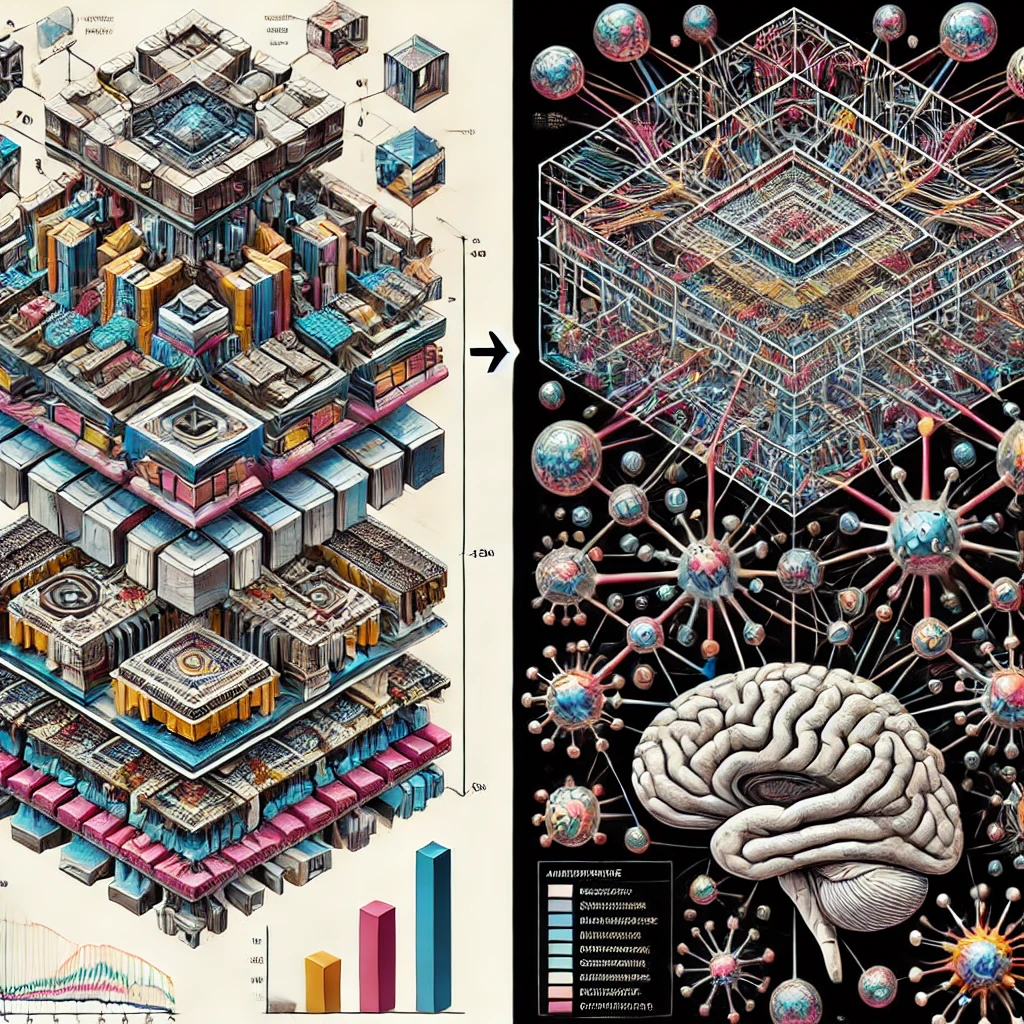
Scaling Intelligence: Quantum Bits to Global Networks
| August 29, 2024
Scaling intelligence is the key to understanding and advancing artificial intelligence. By exploring AI development from a multiscale perspective, we can gain valuable insights into creating intelligent systems that operate at various scales, from quantum foundations to global networks.
Imagine you could zoom in and out of the universe of artificial intelligence, like using Google Earth. At the smallest scale, you’d see the quantum dance of particles powering our most advanced AI chips. Zoom out, and you’d witness intricate neural networks processing vast amounts of data. Keep going, and you’d observe AI systems collaborating in complex ecosystems. At the largest scale, you’d see a global network of AIs working together to solve humanity’s grandest challenges.
This journey across scales is the key to understanding and advancing AI in ways we’ve only begun to imagine. As someone who’s traversed the realms from nanotechnology to large-scale AI systems, I’ve realized that the most profound insights often emerge when we consider AI development from this multiscale perspective.
Today, I’ll take you on a journey through the scales of AI. You’ll see how understanding each level—and the connections between them—can unlock new possibilities and help us navigate the challenges of scaling artificial intelligence. We’ll explore the quantum foundations of AI, the emergence of intelligence in neural networks, the scaling from single AI models to swarm intelligence, and the complexity of global AI networks.
The Quantum Foundation: Where It All Begins
The building blocks of our physical world and AI systems are discrete units of information. In classical computing, this is the bit, either a 0 or 1. However, quantum computing uses qubits, which can exist in multiple states simultaneously (superposition).
This quantum property is analogous to how modern AI systems handle uncertainty and make probabilistic predictions. By embracing quantum-inspired AI systems, we can develop AI that navigates complex, uncertain environments with greater agility.
Moreover, the convergence of quantum foundations and AI methodologies opens up exciting possibilities. Drawing inspiration from the quantum world, we can create faster, more powerful AI systems, better equipped to handle real-world ambiguities and complexities.
From Neurons to Networks: The Emergence of Intelligence
Moving up the scale, we encounter artificial neural networks, inspired by the human brain. Here, the parallels with physical systems become even more intriguing.
Individual artificial neurons are relatively simple, like atoms in a material. They receive inputs, process them, and produce an output. These neurons organize into layers and clusters, much like atoms form molecules, exhibiting more complex behaviors.
Complete neural networks, analogous to macroscale materials, demonstrate emergent properties not obvious from their individual components. This hierarchical organization is key to understanding how AI systems can tackle increasingly complex tasks.
Scaling AI: From Single Models to Swarm Intelligence
As we scale AI systems further, patterns emerge that mirror human social structures. Single AI models are like individual experts, specialized in specific tasks. By combining multiple models, we create ensemble methods, analogous to expert panels, leveraging diverse “opinions” for more robust decisions.
Multi-agent systems take this further, with AI agents interacting, cooperating, and competing, like humans in a marketplace or ecosystem. At the largest scale, swarm intelligence emerges, mimicking the collective behavior of social insects or human societies, where simple individual actions lead to complex, adaptive group behaviors.
Global AI Networks: Navigating Complexity at Scale
As AI systems become more interconnected through the Internet of Things, cloud computing, and global data networks, a new level of complexity arises, mirroring global human society. These global AI networks present unprecedented opportunities and challenges for scaling intelligence.
Emergent behaviors may arise from the interaction of numerous AI systems, just as global trends emerge from individual human actions. A diverse, interconnected AI ecosystem could be more resilient to disruptions and better able to adapt to new challenges.
However, as AI systems become more integrated into global decision-making processes, ensuring ethical behavior at scale becomes crucial. We must consider not just the ethics of individual AI decisions, but how ethical behavior can emerge (or be enforced) in scalable AI systems.
Insights for Scaling Intelligence in AI Development and Governance
Understanding these scales of interaction provides valuable insights for scaling intelligence in AI development and governance. Just as complex materials are built from simpler components, we should design AI systems with modular AI architectures that enable scalability.
Furthermore, different rules may be needed for individual AI systems versus large-scale AI networks, much like how we have different laws for individuals and corporations. The parallels between AI and physical systems suggest that interdisciplinary approaches to AI development can provide valuable insights for scaling intelligence.
Embracing Multiscale Perspective for Scaling Intelligence on AI
By viewing AI through this lens of scales – from quantum bits to global networks – we gain a more holistic view of artificial intelligence. This multiscale perspective allows us to anticipate emergent behaviors, design more robust architectures, develop appropriate governance frameworks, and foster interdisciplinary collaboration, all crucial for scaling intelligence in AI systems.
As we continue to push the boundaries of AI, maintaining this multiscale perspective on AI development will be crucial. It reminds us that in the world of artificial intelligence, as in the physical world, the whole is often greater – and more complex – than the sum of its parts.
To dive deeper into scaling intelligence from a multiscale perspective on AI, explore these related articles:
- From Nanotechnology to AI: Riding the Wave of the Quantum Revolution
- The Quantum Future of AI: How Quantum Computing Will Revolutionize Artificial Intelligence
- Swarm Intelligence in AI: From Ant Colonies to Robotic Swarms
- Governing the Global AI Network: Challenges and Opportunities
By embracing the multiscale perspective on AI development, we can unlock new possibilities, navigate complexities, and create intelligent systems that benefit humanity at every scale.
Recent Blogs
View All
The AI Research Consortium Revolution
| November 11, 2025

The University AI Commercialization Gap
| August 15, 2025

Scaling Intelligence: Quantum Bits to Global Networks
| August 29, 2024

The Future of Shopping is Now
| July 25, 2024

Navigating the Future of AI and Society
| July 24, 2024

